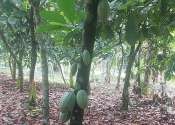Chocolate (pronounced /ˈtʃɒklət/ (help·info) or /-ˈələt/) comprises a number of raw and processed foods produced from the seed of the tropical cacao tree. Cacao has been cultivated for at least three millennia in Mexico, Central and South America, with its earliest documented use around 1100 BC. The majority of the Mesoamerican peoples made chocolate beverages, including the Aztecs and the Maya, who made it into a beverage known as xocolātl, a Nahuatl word meaning "bitter water". The seeds of the cacao tree have an intense bitter taste, and must be fermented to develop the flavor.
After fermentation, the beans are dried, cleaned, and roasted, and the shell is removed to produce cacao nibs. The nibs are then ground and liquified, resulting in pure chocolate in fluid form: chocolate liquor. The liquor can be further processed into two components: cocoa solids and cocoa butter. Pure, unsweetened chocolate contains primarily cocoa solids and cocoa butter in varying proportions. Much of the chocolate consumed today is in the form of sweet chocolate, combining chocolate with sugar. Milk chocolate is sweet chocolate that additionally contains milk powder or condensed milk. "White chocolate" contains cocoa butter, sugar, and milk but no cocoa solids (and thus does not qualify to be considered true chocolate).
Chocolate contains alkaloids such as theobromine and phenethylamine, which have physiological effects on the body. It has been linked to serotonin levels in the brain. Scientists claim that chocolate, eaten in moderation, can lower blood pressure. Dark chocolate has recently been promoted for its health benefits, including a substantial amount of antioxidants that reduce the formation of free radicals, though the presence of theobromine renders it toxic to some animals, such as dogs and cats.
Chocolate has become one of the most popular flavors in the world. Gifts of chocolate molded into different shapes have become traditional on certain holidays: chocolate bunnies and eggs are popular on Easter, chocolate coins on Hanukkah, Santa Claus and other holiday symbols on Christmas, and hearts on Valentine's Day. Chocolate is also used in cold and hot beverages, to produce chocolate milk and hot chocolate.









